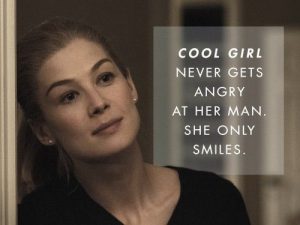Erika M. Thomas’ article “Punishing Unfaithful Wives and Working Mothers: Messages of post-feminism in Contemporary Film” explores common themes in film regarding women during the post-feminism era. Thomas points to several reoccurring themes including the notion that the feminist movement left women with the belief that they cannot raise a family AND have a successful career. This theme is seen in many films in which a strong work-minded female character realizes that happiness is found in a family-orientated life. Is more expected of the woman today than ever before? Women throughout history have generally been seen as one dimensional. Our sole purpose was to be a wife and mother. Other characteristics were rarely represented in film. Is the expectation of women today more complex? I believe so. Many women are expected to work the “double shift” which includes a paid job on top of the emotionally demanding job of being a mother. The recent thriller film Gone Girl documents the frustration women feel trying to compete to be the well-rounded “cool girl”.
“Men always say that as the defining compliment, don’t they? She’s a cool girl. Being the Cool Girl means I am a hot, brilliant, funny woman who adores football, poker, dirty jokes, and burping, who plays video games, drinks cheap beer, loves threesomes and anal sex, and jams hot dogs and hamburgers into her mouth like she’s hosting the world’s biggest culinary gang bang while somehow maintaining a size 2, because Cool Girls are above all hot. Hot and understanding. Cool Girls never get angry; they only smile in a chagrined, loving manner and let their men do whatever they want. Go ahead, shit on me, I don’t mind, I’m the Cool Girl.
Men actually think this girl exists. Maybe they’re fooled because so many women are willing to pretend to be this girl. For a long time Cool Girl offended me. I used to see men – friends, coworkers, strangers – giddy over these awful pretender women, and I’d want to sit these men down and calmly say: You are not dating a woman, you are dating a woman who has watched too many movies written by socially awkward men who’d like to believe that this kind of woman exists and might kiss them. I’d want to grab the poor guy by his lapels or messenger bag and say: The bitch doesn’t really love chili dogs that much – no one loves chili dogs that much! And the Cool Girls are even more pathetic: They’re not even pretending to be the woman they want to be, they’re pretending to be the woman a man wants them to be. Oh, and if you’re not a Cool Girl, I beg you not to believe that your man doesn’t want the Cool Girl. It may be a slightly different version – maybe he’s a vegetarian, so Cool Girl loves seitan and is great with dogs; or maybe he’s a hipster artist, so Cool Girl is a tattooed, bespectacled nerd who loves comics. There are variations to the window dressing, but believe me, he wants Cool Girl, who is basically the girl who likes every fucking thing he likes and doesn’t ever complain. (How do you know you’re not Cool Girl? Because he says things like: “I like strong women.” If he says that to you, he will at some point fuck someone else. Because “I like strong women” is code for “I hate strong women.”)”
This quote demonstrates how women living in the post-feminism era struggle to demonstrate their self-confidence, freedom, sexual expression without expressing TOO much or being TOO dominant. As a woman, you can be sexual..but only in certain situations. You can be career-driven…but your family life will suffer if you focus too much on work. Women are expected to be the perfect amount of all desirable qualities in order to be happy and ultimately have successful romantic relationships.
References:
Thomas, Erika M. “Punishing Unfaithful Wives and Working Mothers: Messages of Postfeminism in Contemporary Film” Media Depictions of Brides, Wives, and Mothers. 2014.
Gone Girl Quote: https://www.goodreads.com/work/quotes/13306276-gone-girl



